(TITC) - Located right next to Cau Da Port, Nha Trang City (Khanh Hoa Province), Nha Trang Institute of Oceanography welcomes thousands of visitors to visit, study, and research every day, of which the Museum of Oceanography is known as the miniature space of Vietnam's sea.
Associate Professor, Dr. Vo Si Tuan, former Director of Nha Trang Institute of Oceanography, said that the Department of Oceanography and Fisheries of Indochina (Service Océanographique des Pêches de l'Indochine) was the predecessor agency of the Indochina Institute of Oceanography, now the Nha Trang Institute of Oceanography, was established on 14th September 1922. This is the marine scientific research agency with the longest history in Vietnam. Speaking of the Institute of Oceanography, one cannot help but mention an related part of it, the Museum of Oceanography, which has been very famous since the 30s of the last century, with the popular name “Nha Trang Oceanography Aquarium”.
Right at the entrance is a beautiful lionfish statue, the symbol of the Nha Trang Institute of Oceanography. In the ocean, lionfish have a graceful, seductive appearance. Scientists call lionfish the "sea princess", some also call it the "queen of the sea".
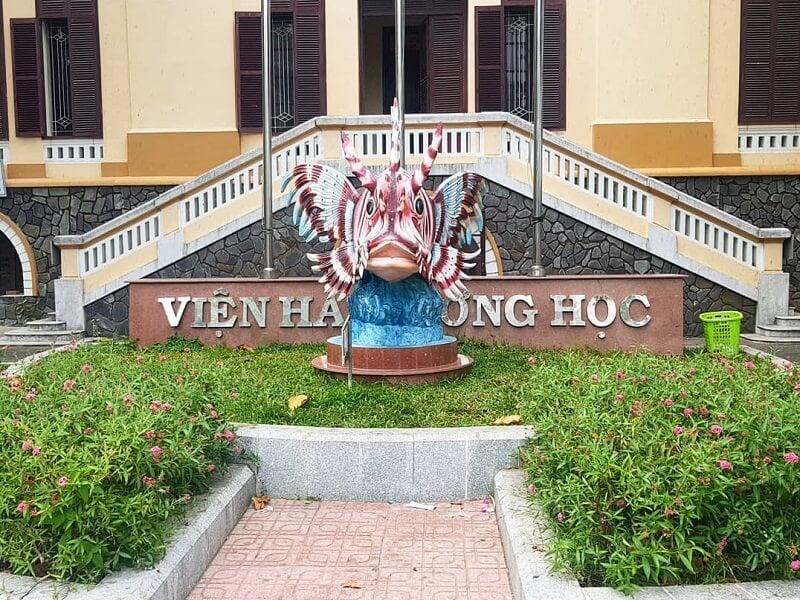
Nha Trang National Oceanographic Museum (Photo: Vinpearl)
Lionfish's scientific name is Pterois Volitans, living in coral reef environments.
The ocean space gradually opens up, first is the marine life display area. There are countless marine creatures here, kept in open tanks, from familiar animals such as prawn, crabs, saltwater fishes to larger fishes such as sharks or rays.
There are currently more than 400 different species of sharks living in seas around the world. According to palaeontologist Stephen Wroe, sharks have up to five rows of teeth, and bites from their jaws correspond to a compressive force of about eight tons!
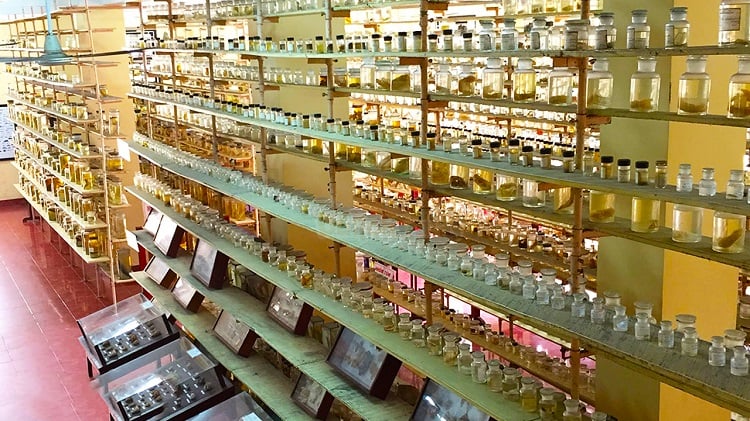
The largest marine museum in Vietnam with superb collections of marine specimens and living creatures (Photo: Vinpearl)
At the large specimen display area, about 200 square metres wide in the Museum of Oceanography, there is a humpback whale skeleton with 18 metres long, weighing nearly 10 tons, that was excavated in Hai Cuong Commune, Hai Hau District, former Nam Ha Province in 1994. This is the first whale skeleton in Vietnam to be displayed in its original form.
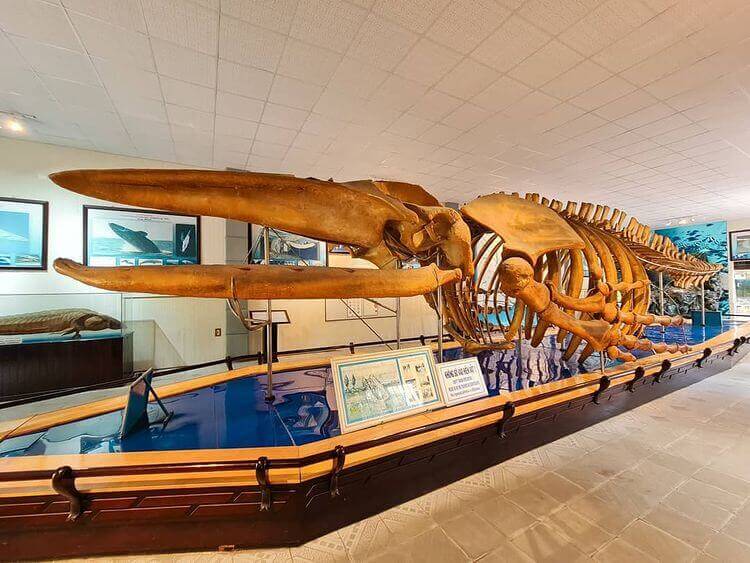
National Oceanographic Museum features a huge skeleton of a humpback whale (Photo: Vinpearl)
Vietnamese fishermen often tell each other stories about whales helping boats overcome strong winds and rough waves at sea. Therefore, the whale is honoured by fishermen as Mr. Nam Hai and being worshipped seriously. What is special is that most of the Whale Mausoleums in Khanh Hoa have titles bestowed by the Nguyen Dynasty kings. And, the annual Cau Ngu festival of Khanh Hoa fishermen also originates from this custom of worshipping the Nam Hai God.
The interesting thing is that until now, many scientists are still researching and decoding the mysterious songs of humpback whales in the sea.
Besides the humpback whale skeleton, there are also two other equally large skeletons: the giant stingray and the dugong. Dugongs are one of the rare marine animals that have mammals and can breastfeed, so they are often called "mermaids" by coastal colonisers. Scientists call this creature: Dugong, which means "beautiful girl" in Indian.
Legend has it that when Western sailors saw Dugong, they thought it was human, so they called it "mermaid" or "siren". Due to overexploitation, Dugong is currently threatened with extinction, at the critically endangered level (CR), according to the Vietnam Red Book. In recent years, the Wildlife At Risk Organization (WAR) in collaboration with Phu Quoc Marine Protected Area has raised the slogan "Please don't kill the mermaid!" Call on the community to participate in protecting Dugong.
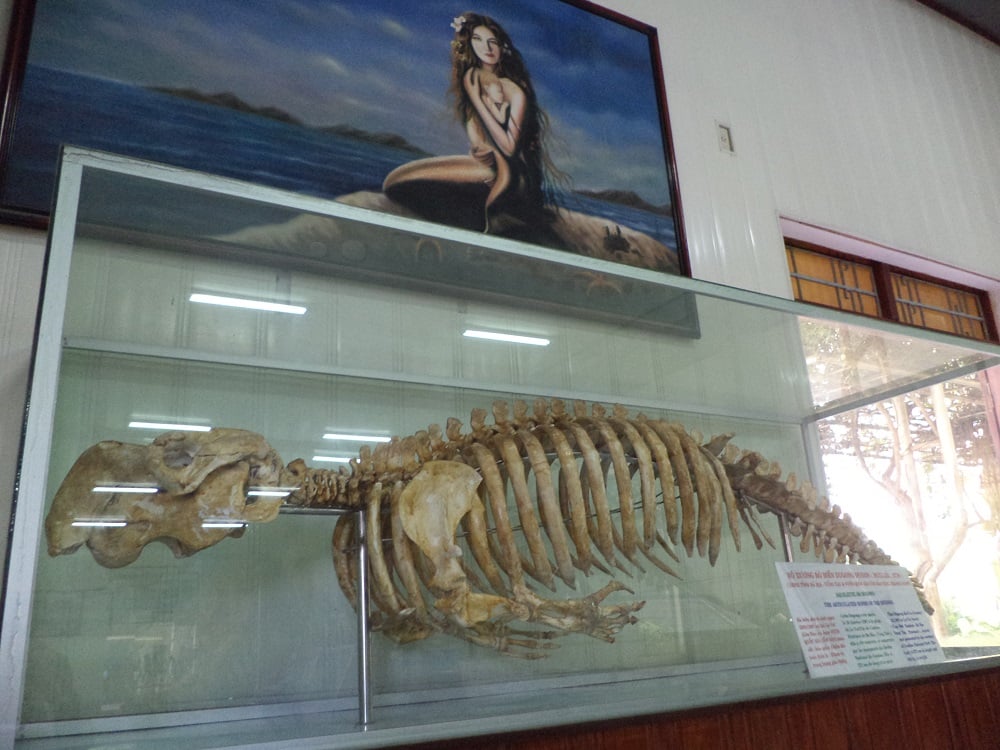
The National Oceanographic Museum boasts the record for the largest collection of 20,000 marine specimens in Vietnam (Photo: Vinpearl)
The ocean always contains many mysteries. On the tunnel through the mountain, many tourists immerse themselves in the shimmering, magical blue ocean scene. Considered a "miniature aquarium", this is a place to display corals, algae and more than 300 species of rare animals to serve the demands of sightseeing as well as studying and researching.
Tourists enjoy observing marine species living in the ocean environment, including some rare species that live very deep at the bottom of the sea. People who love the sea and underwater creatures seem to have a hard time taking their eyes off here, because they are mesmerising scenes.
Coming to the specimen storage area, many people were surprised to learn that there are more than 23,000 marine creatures, belonging to 5,000 species; including many rare specimens such as sturgeon, kingfish, pointed-tailed sunfish, giant clams, seals, false killer whale Pseudorca crassidens…
This is the place recognized by the Vietnam Book of Records Center as "The place to store the largest collection of marine life samples" in the country since 2012. Each specimen is a vivid story of the ocean. For example, a large pearl shell evokes the image of divers searching for pearls at sea. Until now, they still dive manually, despite the huge dangers lurking in their lives such as lack of oxygen and temperature changes, shark attacking. Indeed, sparkling, highly valuable pearls are the crystallisation of the spiritual energy of heaven and earth as well as human sweat and blood.
The topic "Presence in the East Sea" at the Museum of Oceanography displays 18 maps published between 1747 and 1946. These are proofs of Vietnam's sovereignty over Hoang Sa (Paracel Archipelago) and Truong Sa (Spatly Archipelago), from ancient documents to Vietnam's continuous journey of exercising sovereignty over these two archipelagos through scientific research activities from 17th century to present; including the important contributions of many generations of scientific staff at Nha Trang Institute of Oceanography.
The ship De Lanessan, in the memories of experienced Vietnamese marine researchers, the image of that ship is very familiar and sacred. The De Lanessan ship has a tonnage of 750 tons and is 45 metres long. It was handed over by France to the Indochina Department of Oceanography and Fisheries on 21st June 1924, at Bordeaux Port.
On 7th November 1924, the ship docked at Hai Phong Port. Since then, the voyage log of the ship De Lanessan opened in Vietnamese waters, associated with long-term marine exploration and research trips by scientists from the Department of Oceanography and Fisheries of Indochina at that time, the predecessor of the Nha Trang Institute of Oceanography today.
The fieldtrips of the Department of Oceanography and Fisheries of Indochina at that time were determined to be the first marine scientific research activities on the Hoang Sa Archipelago, carried out by Vietnam.
Since 1925, the De Lanessan has been closely associated with the activities of the Institute of Oceanography. With the participation of the De Lanessan ship, the Institute of Oceanography has expanded the scope of research and information collection to the south: Gulf of Thailand, 1925; to the north: Gulf of Tonkin, 1925; to offshore areas: Hoang Sa Archipelago, in 1926 and Truong Sa Archipelago, in 1927 and carried out systematic and periodic explorations on 572 stations, especially two fixed stations, one in Cau Da, Nha Trang and one in Hoang Sa Archipelago.
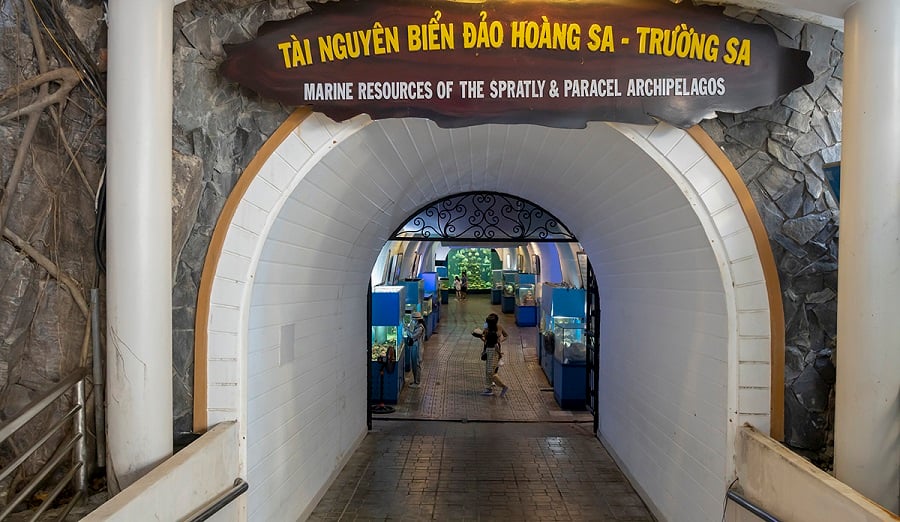
A tunnel showroom in the Museum of Oceanography exhibits significant materials about Vietnamese marine resources and territorial sovereignty (Photo: Vinpearl)
Tourism Information Technology Center